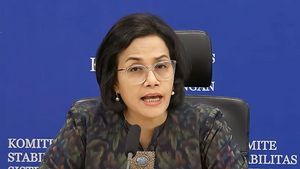JAKARTA - Bank Indonesia (BI) reported that Indonesia's foreign debt (ULN) position at the end of the second quarter of 2023 was recorded at 396.3 billion US dollars. This figure is down when compared to the position of the ULN at the end of the first quarter of 2023 of 403.2 billion US dollars.
Head of the BI Communication Department Erwin Haryono said that Indonesia's external debt on an annual basis contracted growth by 1.4 percent year on year (yoy). This continued the contraction in the previous quarter by 1.9 percent.
It was stated that the contraction in foreign debt growth mainly stemmed from the decline in external debt in the private sector.
"Indonesia's external debt in the second quarter of 2023 fell compared to the previous quarter," he said in a written statement on Tuesday, August 15.
Erwin detailed that the government's external debt decreased compared to the last quarter. The government's external debt position at the end of the second quarter of 2023 was recorded at 192.5 billion US dollars, down compared to the previous quarter's position of 194.0 billion US dollars, or on an annual basis grew 2.8 percent.
"The decline in the position of government external debt in the quarterly manner is due to net payments for foreign loans and global bonds that are due," he said.
Erwin revealed that the government remains committed to managing external debt carefully, efficiently, and accountably, including maintaining credibility in fulfilling basic and interest payment obligations on time.
He said, as one of the components in the State Budget financing instrument, the use of government external debt continues to be directed to support the government's efforts to finance the productive sector and prioritize spending, especially in order to keep Indonesia's economic growth solid amid global economic uncertainty.
"The government's external debt position is relatively safe and under control considering that almost all external debt has a long-term tenor with a share of 99.8% of the total government's external debt," he said.
Meanwhile, the position of private external debt at the end of the second quarter of 2023 was recorded at 194.4 billion US dollars, down from the position in the previous quarter of 199.7 billion US dollars. On an annual basis, private external debt experienced a contraction growth of 5.6 percent (yoy), deeper than the contraction in the previous quarter of 3.0 percent.
Erwin explained that this development was contributed by the increasing contraction of external institutions in finance companies and non-financial companies (non-financial companies) of 7.4 percent and 5.1 percent, respectively, compared to the contraction in the last quarter which was recorded at 3.0 percent, respectively.
"Based on the economic sector, the largest private external debt comes from the manufacturing, financial services and insurance sector, procurement of electricity, gas, steam/hot water, and cold air, as well as mining and quarrying, with a share of 78.2 percent of the total private external debt," he said.
관련 항목:
"Vocational external debt is also still dominated by long-term terms with a share of 75.4 percent of total private external debt," he continued.
In general, Erwin explained that the structure of Indonesia's external debt remains healthy, supported by the application of the precautionary principle in its management. Indonesia's external debt in the second quarter of 2023 remained under control, as reflected in the ratio of Indonesia's external debt to Gross Domestic Product (GDP) which fell to 29.3 percent compared to the ratio in the previous quarter of 30.1 percent.
In addition, the structure of Indonesia's external debt remains healthy, shown by the dominance of long-term external debt with a share reaching 87.7 percent of the total external debt.
"The role of external debt will also continue to be optimized in supporting development financing and encouraging sustainable national economic growth, by minimizing risks that can affect economic stability," Erwin concluded.
The English, Chinese, Japanese, Arabic, and French versions are automatically generated by the AI. So there may still be inaccuracies in translating, please always see Indonesian as our main language. (system supported by DigitalSiber.id)
















